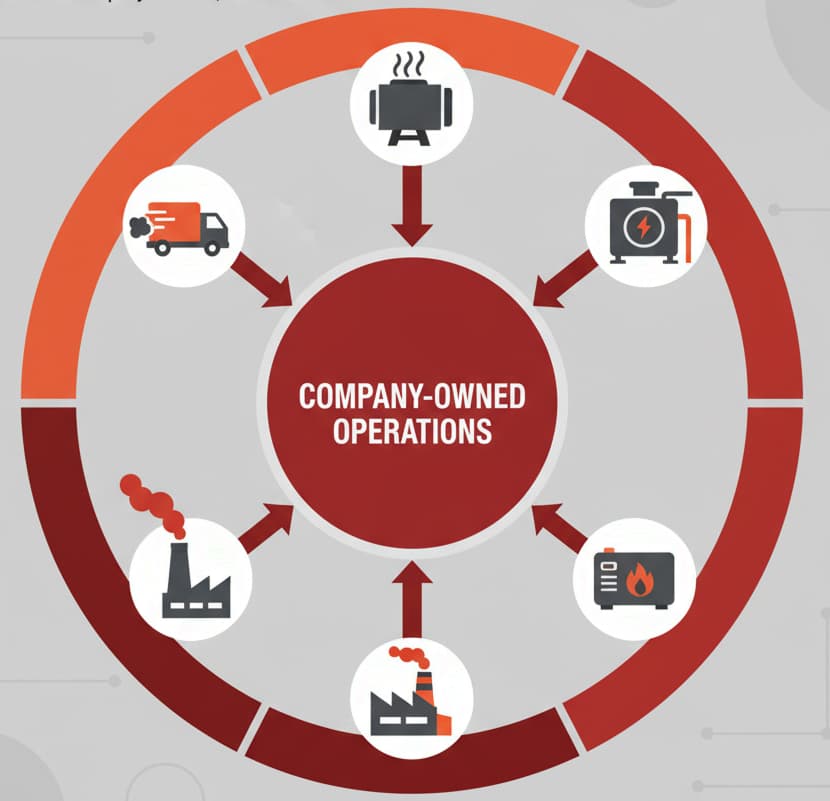Scope 1 Emissions: The Direct Carbon Footprint Companies Can Control
As businesses race toward net zero, Scope 1 emissions represent the most immediate opportunity for climate action. These are the emissions companies create directly—and the ones they can most easily control.

In the complex world of carbon accounting, Scope 1 emissions are refreshingly straightforward: they're the greenhouse gases your company releases directly from sources you own or control. Think of the delivery truck in your parking lot, the boiler heating your office, or the refrigerants leaking from your cooling systems. These emissions happen on your watch, under your roof, and with your equipment.
While Scope 1 typically represents a smaller slice of the corporate carbon pie than supply chain emissions (Scope 3), it's where companies can demonstrate immediate climate leadership. More importantly, it's often where businesses discover that cutting carbon also cuts costs.
From Boilers to Company Cars: The Four Categories of Scope 1
Every company's Scope 1 profile looks different, but emissions typically come from four main sources. Chances are, your organization contributes to more than one:
Stationary Combustion
Any fossil fuel burned in fixed equipment falls here—from the natural gas heating your headquarters to the diesel generators powering remote operations. Manufacturing facilities often see their highest Scope 1 emissions from production equipment and on-site power generation.
Mobile Combustion
This covers your entire fleet footprint. For logistics-heavy industries like retail and distribution, company vehicles can account for the majority of Scope 1 emissions. A single delivery company's truck fleet, for instance, might generate more direct emissions than a dozen office buildings combined.
Fugitive Emissions
These sneaky emissions escape from equipment—refrigerant leaks from HVAC systems, methane seeping from pipelines, or industrial gases escaping during production. What makes them particularly problematic? Some refrigerants are thousands of times more potent than CO2 as greenhouse gases.
Process Emissions
In heavy industry, chemical reactions themselves produce emissions. Cement manufacturing releases CO2 as limestone breaks down. Steel production emits carbon as iron ore transforms. These process emissions often dominate Scope 1 inventories for industrial companies, making them both the biggest challenge and opportunity for innovation.
Why Cutting Scope 1 Pays Off
Smart companies are discovering that Scope 1 reductions deliver benefits beyond carbon cuts:
Control equals opportunity. Unlike supply chain emissions that require complex collaboration, Scope 1 is entirely within your power to change. Switch to electric vehicles, upgrade to efficient equipment, fix those leaks—every action translates directly to reduced emissions.
Efficiency drives savings. That more efficient boiler doesn't just cut emissions; it slashes energy bills. Electric vehicles reduce fuel and maintenance costs. Prevention of refrigerant leaks saves on expensive gas replacements. Companies regularly find that Scope 1 projects pay for themselves through operational savings.
Transparency builds trust. Investors and customers increasingly demand climate action. Demonstrating control over direct emissions proves you can execute on climate commitments. It's also mandatory reporting under the GHG Protocol, making it essential for regulatory compliance.
Quick wins build momentum. Scope 1 projects often deliver faster results than complex supply chain initiatives. These early victories create internal buy-in for broader sustainability efforts and prove the business case for climate action.
How Companies Can Tackle Scope 1 Today
The path to reducing Scope 1 emissions starts with measurement. Companies need to know what they're emitting before they can cut it. This means tracking fuel purchases, monitoring equipment performance, and conducting regular audits to catch those fugitive emissions.
From there, the most effective reduction strategies depend on your industry profile. Logistics companies are electrifying their fleets, starting with last-mile delivery vehicles where the economics already work. Manufacturing facilities are switching from fossil fuel heating to electric heat pumps or biomass systems. Office-based businesses are upgrading building systems and transitioning to renewable energy.
The technology exists today to dramatically reduce most Scope 1 emissions. Electric alternatives are available for most vehicles and equipment. Renewable heating and cooling systems are proven and scalable. Even heavy industry is piloting breakthrough technologies like hydrogen-based steel production and carbon capture for cement manufacturing.
The First Step in a Larger Journey
Scope 1 emissions are where companies prove they can walk the climate talk. These direct emissions offer the clearest path to immediate reductions, operational savings, and stakeholder confidence. They're the foundation of any credible climate strategy.
But let's be clear: the climate challenge won't be solved by Scope 1 reductions alone. The real heavy lifting requires addressing purchased energy (Scope 2) and especially the value chain emissions (Scope 3) that typically dwarf direct emissions. The organizations moving quickly on all three scopes today will be the ones shaping—and thriving in—tomorrow's low-carbon economy.
For companies just starting their climate journey, Scope 1 offers the perfect entry point: measurable, manageable, and meaningful. The question isn't whether to act on Scope 1 emissions, but how quickly you can capture the opportunities they present.
